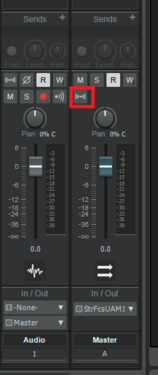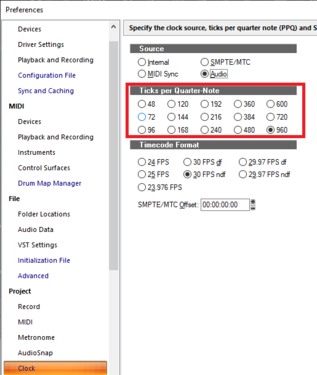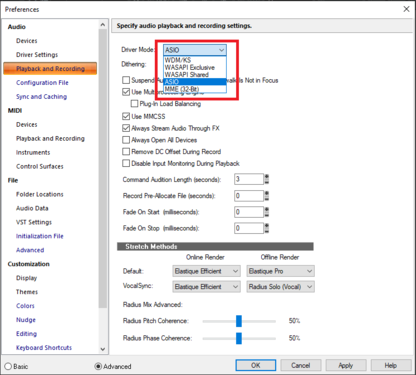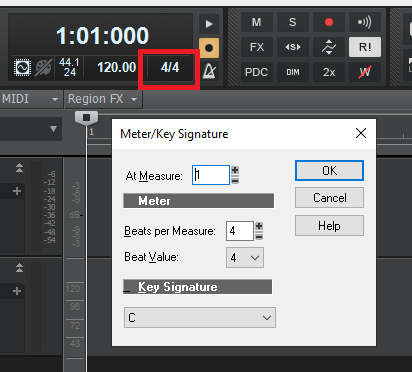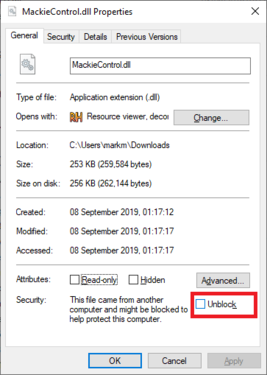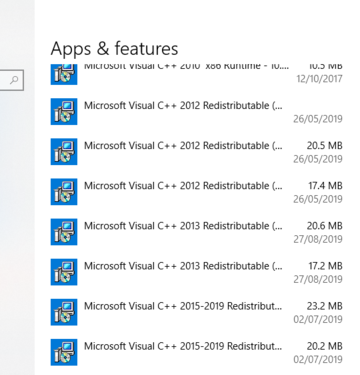-
Posts
7,120 -
Joined
-
Last visited
-
Days Won
39
Everything posted by msmcleod
-

Can't adjust track size by dragging mouse on laptop
msmcleod replied to Michael Fogarty's topic in Cakewalk by BandLab
Have you hit num-pad 0 to enter Advanced Editing mode by mistake? -
-

[ SOLVED ] Select MIDI notes by note length?
msmcleod replied to sadicus's topic in Cakewalk by BandLab
Edit->Select->By Filter is probably best. Set the duration min / max to the number of ticks of the note length. The number of ticks of one beat depends on your project's Ticks per Quarter Note setting: So in the above example, one quarter note is 960 ticks. -
The dialog should look like this: If you've deleted your Metronome bus, just create a new bus, call it "Metronome" and assign its output to your Master bus.
-
Some updates to both the MMcL MackieControl & C4Mapper: MMcL MackieControl Support for custom parameter labels, so if the auto-crunched 6 character parameter label doesn't make sense, you can now give it your own. Note: All of the enhancements & fixes in the MMcL MackieControl (which includes all Azslow3's previous fixes) will be available officially in the next release of Cakewalk, with the exception of multiple independent surface support. Feel free to wait for the official Cakewalk version, however if you want it now, or need multiple independent surface support then use this version. C4Mapper Support for the custom parameter labels above, along with a preview of what parameter labels will look like on your MCU/XT/C4 For non-C4 users: A new "Remap to Modifiers" button which takes the 32 button layout, and maps Row 2 to M1, Row 3 to M2 and Row to M4. This allows you to create your layout on the one screen, but map them to the MCU's (or XT's) 8 VPot's for use with the modifier keys. Mouse over hints are now available on most controls MMcL Mackie Control Installer: https://msmcleod.co.uk/cakewalk/MMcLMackieControlSetup.zip C4 Mapper: https://msmcleod.co.uk/cakewalk/C4Mapper.zip As usual, any issues - please PM me.
-

What are some of you favorite saturation plugins?
msmcleod replied to Max Arwood's topic in Instruments & Effects
Kazrog's TrueIron is currently my favourite: https://kazrog.com/products/true-iron -
The answer to this really depends on what your "general purpose" needs are. If your other software is going to include a lot of background processes, messaging apps, cloud syncs etc, then this will affect the performance of your DAW to some extent. Obviously with faster machines, this may not be an issue. Personally I always use a dual boot for music applications, as I want to keep my DAW boot as clean and minimal as possible. If nothing else, it drastically reduces the risk of some other application breaking something. This of course is my personal choice, not a recommendation.
-
-
Audio quality is exactly the same. The only difference between the two is that ASIO generally has better latency. This isn't always the case though, sometimes WASAPI can be just as good.
-
For dedicated audio devices such as the 2i2, ASIO is usually best as it bypasses all the Windows layers and accesses the audio device directly. However in Windows 10, WASAPI can perform almost as good if not the same as ASIO for most modern devices.
-
Have you set plugin scan to Manual, or is it still doing it automatically every time SONAR starts? Waves plugins do take a long time to scan due to the way the WavesShell works. I'd recommend setting your VST Scan to Manual within Preferences and doing a manual scan when you add a plugin.
-
Scarlet 2i2 2nd gen Focusrite have acknowledged an issue in their driver switching between ASIO / WASAPI that causes a blue screen (and I've heard reports of the same happening in the very latest driver when changing ASIO buffer size). Until they fix this avoid swapping between WASAPI and ASIO. If you can, avoid using your 2i2 as your Windows device (set Windows to use your on-board sound device), and use ASIO exclusively in Cakewalk. If you do need to use your 2i2 as your Windows device, then use WASAPI mode within Cakewalk, and ensure that Windows is using the same sample rate as Cakewalk (keep an eye on this... Windows updates has a habit of changing it).
-
This sounds like what I get if my guitar is too close to my laptop, and/or I'm using a cheap USB to guitar adaptor. Does the noise go away when you move away from your computer?
- 10 replies
-
- sound trouble
- sound problems
-
(and 2 more)
Tagged with:
-

Audio adjust info...PLEASE!!!!
msmcleod replied to Sidney Earl Goodroe's topic in Cakewalk by BandLab
Has the playback timing master / record timing master been changed within Preferences > Audio > Driver Settings? Also check your Synchronization & Record Latency Adjustment settings in Preferences > Audio > Sync & Caching -
@Silvio Gazquez - what audio interface are you using?
-
Just for those curious.... The photo was taken after a long hike in the Bavarian alps - so that's German dark beer. And a very nice one it was too. I've got to confess though, I can count my yearly intake of pints of beer on one (maybe two) hands nowadays. The though of being woken up with a hangover by my daughter at 6am was enough to make me quit going to the pub!
-
Yes, they work in Cakewalk by BandLab and SONAR X3 and above. The Cakewalk bundled ones won't work in any other DAW though.
-
Unfortunately, Cakewalk will only show patch names that are presented to it by the plugin itself. At present, Instrument settings only apply to hardware MIDI instruments. It sounds like Munt MT-32 isn't publishing the names of the patches. You may want to consider contacting the plugin developer to see if they can add patch names to their VSTi.
-
If it's a multi-timbral synth, you're better sticking with Omni. That way, it'll receive all the channels it needs. The Omni setting only applies to hardware MIDI inputs, or VST instruments that send out MIDI data (and only then if you've enabled MIDI output on that synth). It doesn't include the outputs of Cakewalk MIDI tracks. To be honest, I almost always stick with Omni, regardless of whether its multi-timbral or not. The ONLY exception is when I'm using a VST that outputs MIDI data itself (e.g. Jamstix). In this case, I have to make sure that the Jamstix output is unchecked for all other synths other than AD2.
-
If you're running Windows 10, it may be blocking DLL's you've downloaded from the internet. To unblock them, right click on them within Windows explorer and select properties, check the "unblock" checkbox, and click Apply followed by OK, e.g.:
-
Thanks guys! I'm really enjoying my new role as a Baker. It's a huge change after being in software development management elsewhere for the past 20 years, but I certainly won't miss the politics of my previous job. I've joined a fantastic team of incredibly nice and talented guys, all who are passionate and focused on continuing to improve and deliver the best experience we can for all of you. I'll try to keep as active as I can here on the forums, but I'm still getting to grips with 30 years worth of Cakewalk code, so I may not be quite as active as I once was in the short term. There's a bunch of exciting new things in the road map (as well as some bugs to fix), so I'm hoping my being here will make them a reality a bit sooner.
- 14 replies
-
- 16
-

-
@Mcu pro - I've PM'd you to see if this can be resolved.
-
Do not uninstall those - they are not the Microsoft Visual Studio redistributables, they're Intel's ones. The Microsoft ones look like this: When you go to uninstall, it usually gives you the option to "Repair" - repairing normally fixes things. If not, just uninstall them and download them again from Microsoft's website.
-

How do I move my projects to a new PC
msmcleod replied to RICHARD HUTCHINS's topic in Cakewalk by BandLab
I've done this several times in the past. The folders you need to copy are: 1. Your project folder (plus its subfolders). Newer projects will have a folder per project, with the .cwp file in there plus an Audio folder. Anything that has a .cwp, .wrk or .cwb file is a Cakewalk project file. 2. Your Global Audio Folder. If there's no Audio Folder subfolder in a project directory, your projects' audio will be stored here. This will definitely be the case for older SONAR projects. This will be full of .wav (and .WA~ files for really old projects) 3. Your Picture folder. This is where your waveform previews go. It's full of .WTR, .WOV and .TR2 files. If you were using SYSEX banks on your old project, you'll also need to copy those over too. The have the .syx file extension. You can find the new folder locations in CbB inside Preferences->File, under "Folder Locations" and "Audio Data".


